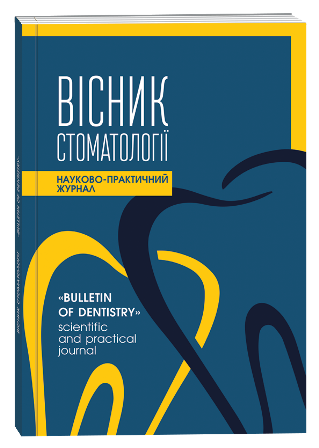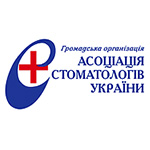MACROGLOSSIA: SIGNS, SYMPTOMS, METHODS OF DIAGNOSTIC AND TREATMENT, INFLUENCE ON THE FORMATION OF DENTOGNATHIC DEFORMATIONS
DOI:
https://doi.org/10.35220/2078-8916-2024-54-4.30Keywords:
orofacial dysfunctions, dentognathic deformations, cause-and-effect relationships, multidisciplinary approachAbstract
The tongue is a powerful muscular organ that significantly affects the development of the dentognathic apparatus. Macroglossia is an enlarged or abnormally large tongue. Studying the anatomical and functional characteristics of
the tongue is a prognostic indicator of effective orthodontic treatment. Purpose of the study. To conduct an analysis of specialized scientific literature to summarize data on the causes, signs, symptoms, methods of diagnosis and treatment of macroglossia and its impact on the formation of dentognathic deformations. Research materials and methods. The article analyzes and studies modern scientific domestic and foreign literature of recent years (PubMed), which highlights the issues of the occurrence, signs, symptoms, treatment methods of macroglossia and its influence on the formation of dentognathic deformations. Results and their discussion. An enlarged and/or elongated, wide, flat tongue indicates macroglossia. Tongue enlargement is most often observed with open and mesial occlusion. Macroglossia is usually diagnosed clinically and confirmed by additional diagnostic methods. Cases of long-term treatment of patients with macroglossia have been described, which involves a multidisciplinary personalized approach. Orthodontic treatment of patients is carried out taking into account the characteristics of the pathological occlusion. The results of most publications are reduced to the description of one or more clinical cases. Fundamental works with retrospective analysis of orthodontic treatment of macroglossia, which address global issues of the influence of the size, shape, position of the tongue and their cause-and-effect relationships with certain dentognathic deformations, are absent. There are also few works that highlight the determination of indicators of the force of pressure of the tongue on the surrounding tissues of the dentofacial apparatus, correlations between the volume of the tongue, the oral cavity, and their relationship. Conclusions. The issues of treating patients with dentognathic deformations with anatomical and functional disorders of the tongue are in close causal relationship, therefore, require a multidisciplinary approach to solving them. Systematization of the causes of the impact of macroglossia on the dentognathic apparatus and the organism as a whole should include clinical and morphological aspects that arise in the embryonal and postembryonal period of human life.
References
ova MC. Understanding and Treating Macroglossia. Int J Orthod Milwaukee. 2016; 27(2):47-49.
Мельник А.О., Шафета О.Б., Сулейманов А.М. Топографічні показники язика у дітей з вродженими та набутими порушеннями міжщелепного співвідношення. Міжнародний журнал педіатрії, акушерства та гінекології. 2019; 13(2):38. (Мат. науково-практ. конф. з міжн. участю «Міждисциплінарні підходи до діагностики та лікування дитячих хвороб», 18-19 квітня 2019 року, Київ, 2019).
Хірургічна стоматологія та щелепно-лицева хірургія дитячого віку ; нац. підр / Л.М. Яковенко та ін.; за редакцією Л.М. Яковенко. Київ: Медицина; 2022. 496 с.
Melnyk A., Filonenko V. Clinical and Phonetic Features of Dentognathic Deformations, Their Orthodontic Treatment (Chapter). In: Ardelean L.C. and Rusu L-C.C., editors. Human Teeth – From Function to Esthetics. UK: IntechOpen; 2023. Р. 315-333. doi: 10.5772/intechopen.109636
Ruscelloa D.M., Douglasa C., Tysona T., Durkeeb M. Macroglossia: a case study. J Commun Disord. 2005. №38(2). Р. 109-122. doi:10.1016/j.jcomdis.2004.06.001.
Deshkar M., Thosar N.R., Kabra S.P, Yeluri R., Rathi N.V. The Influence of the Tongue on the Development of Dental Malocclusion. Cureus. 2024. №16(5). Р. e61281. doi:10.7759/cureus.61281.
Núñez-Martíneza P.M., García-Delgadoa C., Morán- Barrosoa V.F., Jasso-Gutiérrez L. Macroglosia congénita: características clínicas y estrategias de tratamiento en la edad pediátrica. Boletín Médico del Hospital Infantil de México. 2016. №73(3). Р. 212-216. doi:10.1016/j. bmhime.2017.08.003.
Gildener-Leapman N., Meyers A., González B. Macroglossia. 2024. Available at: https:// emedicine.medscape.com/article/873658-overview#a10
Макроглосія у дітей і дорослих. 2021. Доступно на: https://ua.iliveok.com/health/makroglosiya-u-ditey-i-doroslyh_131521i15939.html
Topouzelis N., Iliopoulos C., Kolokitha O.E. Macroglossia. Int Dent J. 2011. №61(2). Р. 63-69. doi: 10.1111/j.1875-595X.2011.00015.x.
МКБ-11 для ведення статистики смертності та захворюваності (версія: 01.2023). Доступно на: https://icd.who.int/browse11/l-m/ru#/http://id.who.int/icd/ entity/670519908
Hotokezaka H., Matsuo T., Nakagawa M., Mizuno A., Kobayashi K. Severe dental open bite malocclusion with tongue reduction after orthodontic treatment. Angle Orthod. 2001. №71(3). Р. 228-236. doi: 10.1043/0003-3219(2001)071<0228:SDOBMW>2. 0.CO;2.
Головко Н.В., Наджиб Г.I. Розміри та форма язика у пацієнтів з аномаліями прикріплення та розмірів його вуздечки при різних зубощелепних аномаліях. Вісник ВДНЗУ «Українська медична стоматологічна академія». 2010. №1(3). С. 6-9. (Мат. Всеукраїнської науково-практ. конф. «Медична наука – 2010», Полтава, 2010).









